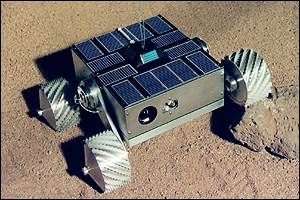| Plastic Muscles for Robots |
|
|||||
|
Stiquito Kit BattleKits Robot Toys Solar Kits Robot Arms Robosapien Basic Stamp Kits Lego MindStorms
Hobby Robots Robot Sports Electronics Mechanics Robot Minds Books for Kids Robots at Work Microcontrollers Advanced Books Used Books
Robot Motors Remote Controls Robot Parts Robot Tools Magazines Robot Videos Robot News RoboLinks Contact
|
Courtesy of BBC News The polymer material will contract and relax, just like the muscles in human fingers, when an electrical voltage is applied. The US space agency, Nasa, believes the strips will greatly simplify robotic spacecraft tasks such as grabbing and lifting objects. The technology could even lead in the future to the development of insect-like robots that emulate biological creatures, Nasa says. Window wipers The artificial muscles, or electroactive polymers (EAPs) as they are known, will get their first test on a small Nasa rover destined to explore an asteroid.
This 2002 mission will land a palm-sized, wheeled vehicle on Nereus or 1989ML and return a sample of the asteroid to Earth. The viewing windows of optical and infrared science instruments onboard the rover will be kept clear of dust by two miniature EAP wipers. The Nasa team working on EAPs at the Jet Propulsion Laboratory in Pasadena has developed two types of artificial muscles that respond quickly to small amounts of electricity by lengthening or bending. Charged particles The first is a flexible polymer ribbon constructed from chains of carbon, fluorine and oxygen molecules. When an electric charge flows through the ribbon, charged particles in the polymer get pushed or pulled on the ribbon's two sides, depending on the polarity. The effect is to make the ribbon bend. Using four such ribbons, the team has made a gripper that can pick up a rock. The second EAP consists of thin sheets wrapped into cigar-like cylinders that stretch when one side of a sheet is given a positive charge and the other a negative charge. These charges cause the wrapped sheet to contract toward the center of the cylinder, and this constriction forces the cylinder to expand lengthways. When the power supply is turned off, the cylinder relaxes, enabling it to lift or drop loads. New paradigm This approach has huge potential for robot design which currently relies on power-hungry gears and hydraulics to grab and move objects. "Electroactive polymers are changing the paradigm about the complexity of robots," says Dr Yoseph Bar-Cohen who leads the research. "In the future, we see the potential to emulate the resilience and fracture tolerance of biological muscles, enabling us to build simple robots that dig and operate co-operatively like ants, soft-land like cats or traverse long distances like a grasshopper." The team would also like to extend the technology for medical uses with EAPs being used to replace damaged human muscles. "My hope is someday to see a handicapped person jogging to the grocery store using this technology," Dr Bar-Cohen says, although he concedes such applications may be decades away. |
|||||
|
Advertise your product on RobotBooks.com Beginners Books |
Hobby Robots |
Robot Sports |
Electronics |
Mechanics |
Robot Minds |
Robot Fiction |
||||||
 Artificial muscles made from strips of highly flexible,
lightweight plastic are being developed for use on future space robots and rovers.
Artificial muscles made from strips of highly flexible,
lightweight plastic are being developed for use on future space robots and rovers. 